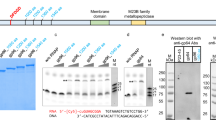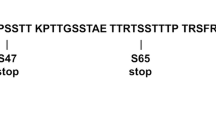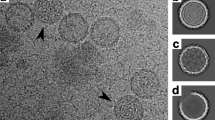Abstract
INVESTIGATIONS of the multiplication of alphaviruses such as Semliki Forest virus (SPY) or Sindbis virus have suggested that the three glycoproteins1 (E1, E2 and E3) located in the viral envelope are initially synthesised as a large precursor poly-peptide which contains the amino acid sequences of them all2–7. This protein, NVP97 (ref. 5), is cleaved to give E1 and another precursor polypeptide, NVP63, which is in turn cleaved to give E2 and E3 (refs 6 and 7). By analogy with the picorna-virus system, it has been widely suggested that all the viral structural proteins are derived by cleavage of a common precursor and, indeed, proteins of a size sufficient to encompass the viral capsid protein, as well as the envelope proteins, have been found in infected cells treated with amino acid analogues and inhibitors of proteolytic enzymes10,11, and in cells infected with certain classes of temperature-sensitive mutant2,3,12,13. Doubts have been cast on the validity of the analogy, however, by reports8,9,16–19 that cell-free translation of SFV or Sindbis virus mRNA in several systems resulted in the production of discrete viral proteins. This situation is in marked contrast to that of translation of picornavirus RNA, in which a spectrum of polypeptides of various lengths is formed by premature termination at many points along the messenger; since no post-translational cleavage seems to take place, no polypeptides found in the mature virus or in infected cells are formed20,21. The possibility arose, therefore, that the alphavirus capsid protein and envelope proteins are synthesised independently.
This is a preview of subscription content, access via your institution
Access options
Subscribe to this journal
Receive 51 print issues and online access
$199.00 per year
only $3.90 per issue
Buy this article
- Purchase on Springer Link
- Instant access to full article PDF
Prices may be subject to local taxes which are calculated during checkout
Similar content being viewed by others
References
Garoff, H., Simons, K., and Renkonen, O., Virology, 61, 493–504 (1974).
Schlesinger, M. J., and Schlesinger, S., J. Virol., 11, 1013–1016 (1973).
Strauss, J. H., Burge, B. W., and Darnell, J. E., Virology, 37, 367–376 (1969).
Ranki, M., J. gen. Virol., 15, 59–67 (1972).
Morser, M. J., Kennedy, S. I. T., and Burke, D. C., J. gen. Virol., 21, 19–29 (1973).
Schlesinger, S., and Schlesinger, M. J., J. Virol., 10, 925–932 (1972).
Simons, K., Keränen, S., and Kääriänen, L., FEBS Lett., 29, 87–91 (1973).
Clegg, J. C. S., and Kennedy, S. I. T., FEBS Lett., 42, 327–330 (1974); Europ. J. Biochem. (in the press).
Simmons, D. T., and Strauss, J. H., J. molec. Biol., 86, 397–409 (1974).
Pfefferkorn, E., and Boyle, M. K., J. Virol., 9, 187–188 (1972).
Morser, M. J., and Burke, D. C., J. gen. Virol., 22, 395–409 (1974).
Scheele, C. M., and Pfefferkorn, E., J. Virol., 5, 329–337 (1970).
Waite, M. R. F., J. Virol., 11, 198–206 (1973).
Saborio, J. L., Pong, S.-S., and Koch, G., J. molec. Biol., 85, 195–211 (1974).
Schlesinger, M. J., Schlesinger, S., and Burge, B. W., Virology, 47, 539–541 (1972).
Cancedda, R., and Schlesinger, M. J., Proc. natn. Acad. Sci. U.S.A, 71, 1843–1847 (1974).
Cancedda, R., Swanson, R., and Schlesinger, M. J., J. Virol., 14, 652–663; ibid., 664–671 (1974).
Wengler, G., Beato, M., and Hackemack, B. A., Virology, 61, 120–128 (1974).
Smith, A. E., Wheeler, T., Glanville, N., and Kääriänen, L., Eur. J. Biochem., 49, 101–110 (1974).
Kerr, I. M., Brown, R. E., and Tovell, D. R., J. Virol., 10, 73–81 (1972).
Öberg, B. F., and Shatkin, A. J., Proc. natn. Acad. Sci. U.S.A, 69, 3589–3593 (1972).
Söderlund, H., Intervirology, 1, 354–361 (1973).
Author information
Authors and Affiliations
Rights and permissions
About this article
Cite this article
CLEGG, J. Sequential translation of capsid and membrane protein genes of alphaviruses. Nature 254, 454–455 (1975). https://doi.org/10.1038/254454a0
Received:
Issue Date:
DOI: https://doi.org/10.1038/254454a0
This article is cited by
-
Nucleotide sequence of cDNA coding for Semliki Forest virus membrane glycoproteins
Nature (1980)
-
Messenger ribonucleoprotein complexes containingin vitro-synthesized 26S and 42S Semliki Forest virus RNA
Archives of Virology (1979)
-
Glycosylation is not necessary for membrane insertion and cleavage of Semliki Forest virus membrane proteins
Nature (1978)
Comments
By submitting a comment you agree to abide by our Terms and Community Guidelines. If you find something abusive or that does not comply with our terms or guidelines please flag it as inappropriate.



